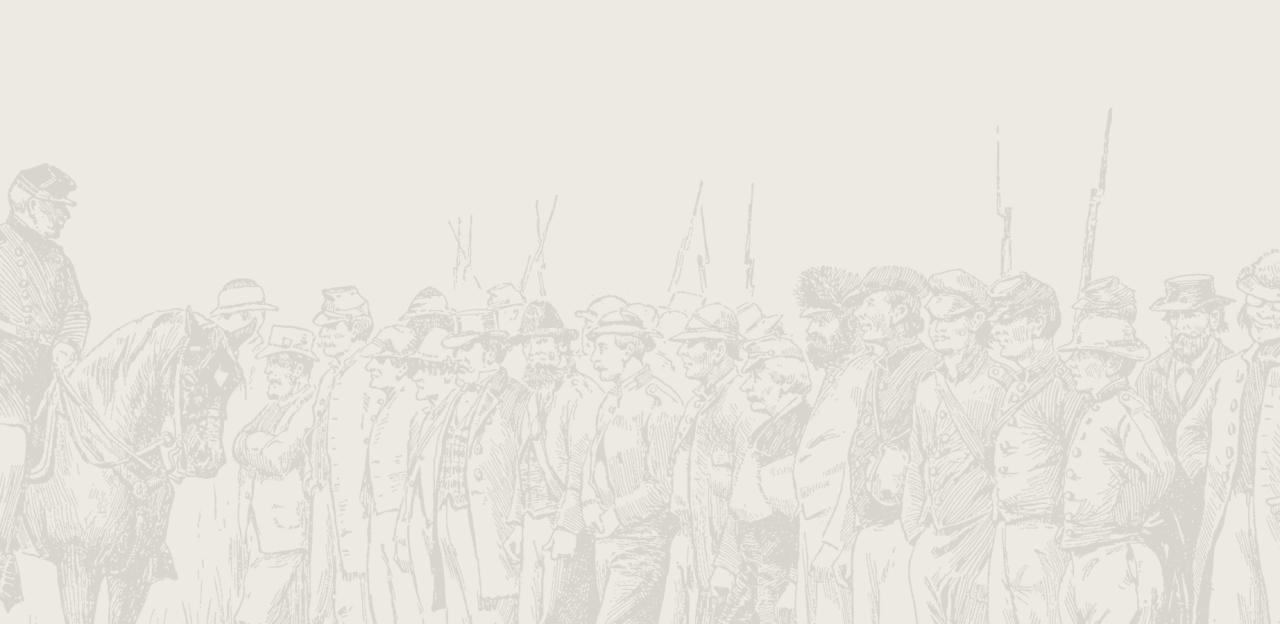Fredericksburg

The Battle of Fredericksburg
The Battle of Fredericksburg, fought December 11-15, 1862, was one of the largest and deadliest of the Civil War. It featured the first opposed river crossing in American military history. Union and Confederate troops fought in the streets of Fredericksburg in the Civil War’s first taste of urban combat. And with nearly 200,000 combatants, no other Civil War battle featured a larger concentration of soldiers.
After failing to pursue Gen. Robert E. Lee’s army aggressively after the Battle of Antietam, Maj. Gen. George B. McClellan was removed from command of the Army of the Potomac. His replacement, Maj. Gen. Ambrose E. Burnside, feeling the pressure from Washington to move quickly, developed a plan to beat Lee to the Confederate capital city of Richmond.
From his camps around Warrenton, Burnside planned to abandon the army’s movement southwest in favor of a quick dash southeast toward the lower Rappahannock River. There, he would cross quickly and position himself between Lee and the direct route to Richmond. His plan depended upon speed of execution and was initially successful. Leaving the Warrenton area on November 15, Burnside moved his 120,000-man army 35 miles to Falmouth on the north bank of the Rappahannock in two days.
Opposite Falmouth was the river port town of Fredericksburg, then occupied by only a few hundred Confederates. The quiet town, half-way between Richmond and Washington D.C., had largely escaped the ravages of the war. The bridges across the river there had been destroyed earlier, however, so Burnside planned for portable pontoon bridges to be sent forward to his army. Arriving in Falmouth, Burnside found no bridging materials waiting for him; bureaucratic and logistical delays in Washington had slowed their arrival on the riverbank. Burnside forfeited the surprise he had gained on Lee and settled in to wait for the bridges.
While Burnside waited, Lee gathered his army. Gen. James Longstreet’s wing moved east from Culpeper and Gen. Thomas J. “Stonewall” Jackson’s men hurried toward the Rappahannock from the Shenandoah Valley. Longstreet took up a position on Marye’s Heights, overlooking Fredericksburg from the west. To the south, Jackson’s men entrenched in a line stretching over Prospect Hill and on to Hamilton’s Crossing four miles from the town.
On November 25, the long-awaited pontoon bridges began to arrive. An engineer regiment began to assemble them opposite the town in the foggy pre-dawn hours of December 11. Confederate riflemen, hiding in buildings along the riverbank, harassed the engineers and slowed their work. Senior Union commanders conferred as the bridging process ground to a halt. Burnside approved a plan to shell the town to drive out the Confederate snipers. Late that morning, over 150 Federal guns arrayed on Stafford Heights bombarded the town, blasting scores of buildings and terrifying the civilians that had remained in their homes and cellars. After four hours of shelling, the engineers returned to their bridgework and the riflemen resumed their shooting.
Another plan was needed. Burnside again met with his officers and approved a plan to send a landing party across the river to hunt down the Confederate snipers and secure a bridgehead in the town. Colonel Norman Hall, a brigade commander in the nearby II Corps, volunteered his brigade to row across the river. Under fire, regiments from Michigan and Massachusetts successfully crossed the Rappahannock and drove the riflemen from the riverbank. More Union regiments followed across the river, and the Confederates withdrew after few hours of house-to-house street fighting.
On December 12th, the remainder of Burnside’s army crossed the river and occupied Fredericksburg. His plan was to use the nearly 60,000 men in Maj. Gen. William B. Franklin’s Left Grand Division to crush Lee’s southern flank held by Jackson while the rest of his army held Longstreet in position on Marye’s Heights and supported Franklin if needed.
The next day, the Union main assault against Jackson produced initial success. In an area later known as the Slaughter Pen, Maj. Gen. George G. Meade’s division briefly pierced Jackson’s line and held the promise of destroying the Confederate right. However, lack of coordinated reinforcements and Jackson’s powerful counterattack stymied the effort. Both sides suffered heavy losses with no gain on either side.
In the meantime, Burnside’s “diversion” against Longstreet’s veteran Confederate soldiers produced horrific Union casualties. The front of Longstreet’s position was a sunken farm lane at the foot of Marye’s Heights full of Confederates three ranks deep. Wave after wave of Federal soldiers advanced over open ground to take the road, but each was met with devastating rifle and artillery fire from the nearly impregnable Confederate position. Elements of seven Union divisions were fed into the massive assault. Confederate artillerist Edward Porter Alexander’s claim that “a chicken could not live on that field” proved to be entirely prophetic.
Both sides remained in place on December 14. That evening, as darkness fell on the battlefield strewn with dead and wounded, it was abundantly clear that a signal Confederate victory was at hand. The Army of the Potomac suffered over 12,500 casualties, nearly two-thirds of them in front of Marye’s Heights. By comparison, Lee’s army suffered some 6,000 losses. Lee, watching the Confederate victory unfolding from his hilltop command post exclaimed, “It is well that war is so terrible, or we should grow too fond of it.”
During the fighting, Union Generals C. Feger Jackson and George Bayard, and Confederate Generals Thomas R.R. Cobb and Maxey Gregg were killed. Six weeks after the battle, President Lincoln removed Burnside from command of the Army of the Potomac, and the war would go on two-and-a-half more years.


